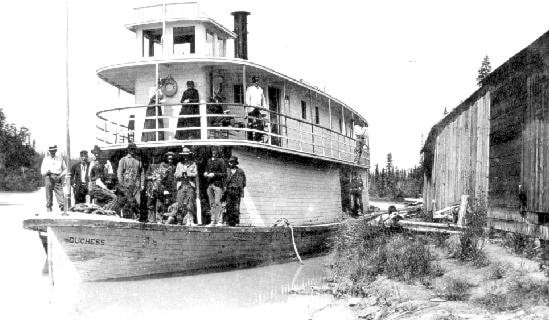"Captain Frank Armstrong bumped a lot of scenery ... but he always got through." Robert Randolph Bruce, Lt. Governor of B.C. 1926-31
Jim Cameron
On the evening of Thursday, April 28, 1898, the citizens of Fort Steele gathered to mark the end of winter with the firing of sticks of dynamite, lively tunes from the Fort Steele Brass Band and general cheering and jubilation all around.
Technically, the first day of spring came weeks earlier but for the townsfolk it wasn't the calendar that marked the event. For them and many others along the Kootenay River the true solstice came when the first steamboat of the year hove into view, in this case the J.D. Farrell, carrying 16 tons of merchandise from Jennings, Montana.
It took her 12 days to fight her way up the Kootenay River which, for Captain McCormack and his crew, wasn't bad given the low water, sandbars, rocks and snags.
The Farrell, built during the winter at Jennings, was the largest craft on the river at 126 feet stem to stern and a 26 foot beam. She was a shapely boat for the time and place, fitted as she was with elegant (all things considered) staterooms, bathrooms, a dining room all electrically illuminated, plus a searchlight enabling nighttime navigation.
It was a long haul but once the water was high she and three or four other boats would do the trip in 24 hours each week. Before the railway came to the Kootenays, when a trip by wagon from the towns of Golden or Kalispell entailed a very arduous journey, travelling by boat was a luxury.
Of course, it wasn't necessarily the safest way to go — the J.D. Farrell made only eight trips before striking a rock and sinking, a fate that befell many of the vessels although generally no one was hurt and oftentimes the boat was back on the river in short order.
The Farrell was not the first steamship on the river, mind you. Boats had been plying the waters since the "Annerly," ran the river in 1893, bringing supplies to the North Star Landing upriver from Fort Steele and loading tons of ore for the return journey.

Pictured: The sternwheeler Annerley, ca. 1893. The first steamer on the upper Kootenay River, – Wiki Commons
The East Kootenay region forms the upper eastern edge of the Columbia River Basin, an area that includes southeastern B.C., most of Idaho, Oregon and Washington, western Montana and small portions of Nevada, Utah and Wyoming. The Kootenay River runs south from near Golden and then back north to drain into the Columbia River near Castlegar. The Columbia River runs north from Columbia Lake near Canal Flats and then south and west through the United States to Astoria, Oregon, pouring more water into the Pacific Ocean than any river in North or South America. The fact that the two rivers are only a mile or so apart at Columbia Lake spurred William Baillie-Grohman, in 1889, to undertake the construction of a canal at what is now known as Canal Flats: A man a plan, a canal, a failure. It was used but twice.
Of the numerous riverboat pilots of the day along the Kootenay and Columbia, unarguably the best was Francis Patrick Armstrong. Born in Sorel, Quebec, to the Hon. James and Charlotte Armstrong, Frank first came to the area as part of a group of engineers under Major Albert Rogers, surveying the route that would become the Rogers Pass. Frank settled near Golden and took up farming for a time. During the winter of 1882-83 he strapped on his snowshoes and made an overland trip from Golden to Joseph Prairie (now Cranbrook) to deliver the mail. Undoubtedly finding the journey somewhat taxing he soon began construction of a riverboat from salvaged lumber. The craft was 75 feet long, 17 feet wide and powered by 45 year-old engines salvaged from a ferry on the St. Lawrence River.
"She's a pretty crude steamship," he stated when he launched her in the summer of 1886 along the Columbia River, a narrow, shallow, crooked route, dry in the autumn, frozen in the winter and fraught with obstacles.
She sailed successfully and with great fanfare into Lake Windermere on her maiden voyage and continued to do for the next two years carrying settlers, livestock, food, merchandise and mail. When she sprang a leak and sank he built the Duchess II and the Marion, both much improved from his first effort, the latter of which drew only 18 inches of water when fully loaded. As Captain Armstrong pointed out, "the river's bottom was often very close to the river's top."
The steamers plied the Columbia, often stopping along the way to see to settler's needs, deliver mail and load wood for the journey.
Captain Armstrong built and sailed numerous boats over the next 20 years. In 1915 he accepted a volunteer overseas commission by the British Government and, at age 56, undertook service as superintendent of all military vessels on the Tigris and Nile Rivers, at one point barely escaping with his life when his ship was torpedoed in the Mediterranean.
Following the war he returned to the Kootenays as a member of the Department of Public Works.
Thirty-four years after the Duchess made her initial run, he captained the steamer Nowitka from Golden, carrying material to construct a bridge at Briscoe which effectively closed the river to paddlewheel navigation.
In October, 1922, he was struck by a broken cable on a wharf in Kaslo, suffering a broken hip and internal injury from which he never recovered. He died in Vancouver on January 26, 1923.
Endnote: A more thorough discussion of the life and times of Frank Armstrong may be found in the B.C. Historical News, Vol. 28, No.2, 1995, written by his great- niece, the late Winnifred Weir. Frank was brother to J.F. Armstrong, local government agent for whom Cranbrook's Armstrong (9th) Avenue is named.
